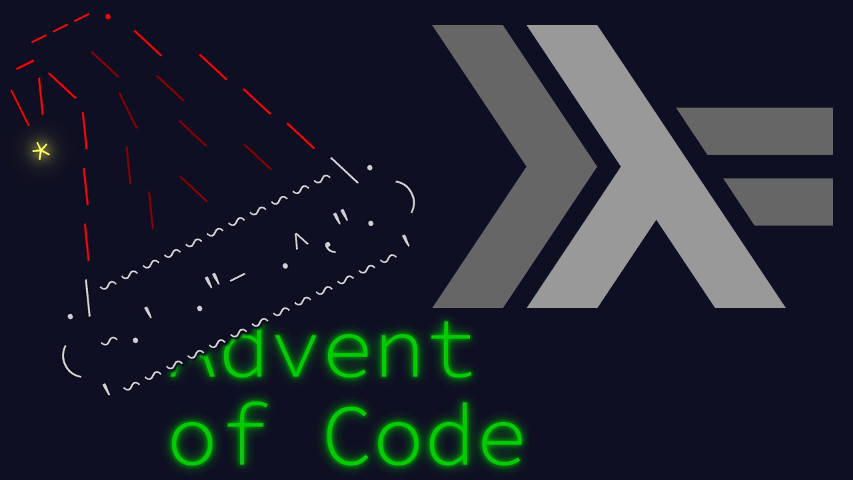Today’s Advent of Code, “Garden Groups”, is mostly about grouping plots of land into patches, so a typical union-find problem. Let’s start with the relevant imports, this being literate Haskell.
import Control.Arrow ((***),(&&&))
import Control.Monad (forM_,when)
import Control.Monad.ST (ST,runST)
import Control.Monad.Trans (lift)
import Data.Array (Array,listArray,bounds,(!),indices,inRange)
import Data.Array.ST (STArray,newArray,modifyArray',freeze)
import Data.Equivalence.Monad (runEquivT,equate,classDesc)
import Data.Semigroup (Min(Min,getMin),Sum(Sum,getSum))Parsing is more or less the same as every second day.
type Grid = Array (Int,Int)
parse :: String -> Grid Char
parse s = listArray ((1,1),(h,w)) (concat raw) where
raw = lines s
h = length raw
w = length (head raw)Now the meat of the day is grouping the plots. Part 1 asks for some computation based on perimeters, so we’ll be storing those too. Both parts ask for something related to areas, so we’ll store those as well. Part 2 asks for something more complicated, so we’ll also remember a patch identifier of sorts. (That happens to be the first encountered position coordinates involved in the group.)
type Processed = (Grid Int,Grid (Int,Int),Grid Int)We trigger the process using the equivalence package’s
initializer (Min i,Sum 1) representing the group
representative’s coordinages and an individual plot’s area, so we can
use the standard semigroup appending operation (<>)
as a merge operation.
process :: Grid Char -> Processed
process g = runST $ runEquivT (\i -> (Min i,Sum 1)) (<>) $ doFor perimeters, we’ll maintain an external array. It starts initialized at 4, meaning each square plot has 4 surrounding units of fence.
ps <- lift (newArray (bounds g) 4 :: ST s (STArray s (Int,Int) Int))We’ll then define a merge operation, that we’ll invoke on each pair
of adjacent plots. If the conditions are met, namely both plots are of
the same type of plant, we’ll merge them in the equivalence
structure as well as decrease both sides’ fences by the one between the
both.
let maybeMerge u v = when (g!u == g!v) $ do
equate u v
lift $ modifyArray' ps u pred
lift $ modifyArray' ps v predWe can now group all relevant plots.
let ((t,l),(b,r)) = bounds g
forM_ [t..b] $ \i ->
forM_ [l..r] $ \j -> do
when (j < r) $ maybeMerge (i,j) (i,j+1)
when (i < b) $ maybeMerge (i,j) (i+1,j)We’ll extract identifiers and areas as separate arrays for easier external consumption, and return it all.
(identifiers,areas) <-
( listArray (bounds g) . map getMin ***
listArray (bounds g) . map getSum
) .
unzip <$>
mapM classDesc (indices g)
perimeters <- lift (freeze ps)
pure (perimeters,identifiers,areas)In part 1, the requested computation is the sum per patch of product of area by perimeter, which we can express more or less directly.
part1 :: Processed -> Int
part1 (perimeters,_,areas) = sum (price <$> indices areas)
where price u = (areas ! u) * (perimeters ! u)Part 2 is trickier: it asks for the product of area by number of sides. Sides are slightly messy, but they’re dual and equal in cardinality to corners, which we can compute easily, if not a bit verbosely.
The general idea is to go plot by plot. A given plot has a convex corner if two adjacent plots are not a part of the same patch. A given plot is a non-convex corner if two adjacent plots are a part of the same patch, but the diagonal one in-between is not.
It’s barely worth it to factor out the side pairing, so it results in 2×4 cases.
part2 :: Processed -> Int
part2 (_,identifiers,areas) = sum (discountedPrice <$> indices areas)
where discountedPrice (i,j) = areas!(i,j) * corners
where sameShape v =
inRange (bounds areas) v &&
(identifiers!v == identifiers!(i,j))
[ nw,n,ne
, w,_, e
,sw,s,se
] = map sameShape
[(i-1,j-1),(i-1,j),(i-1,j+1)
,(i, j-1),(i, j),(i, j+1)
,(i+1,j-1),(i+1,j),(i+1,j+1)]
corners =
fromEnum (not n && not w) +
fromEnum (not n && not e) +
fromEnum (not s && not w) +
fromEnum (not s && not e) +
fromEnum (n && w && not nw) +
fromEnum (n && e && not ne) +
fromEnum (s && w && not sw) +
fromEnum (s && e && not se)A little wrapper to invoke it all.
main :: IO ()
main = interact $ show . (part1 &&& part2) . process . parseThis concludes today’s puzzle. See you tomorrow!



